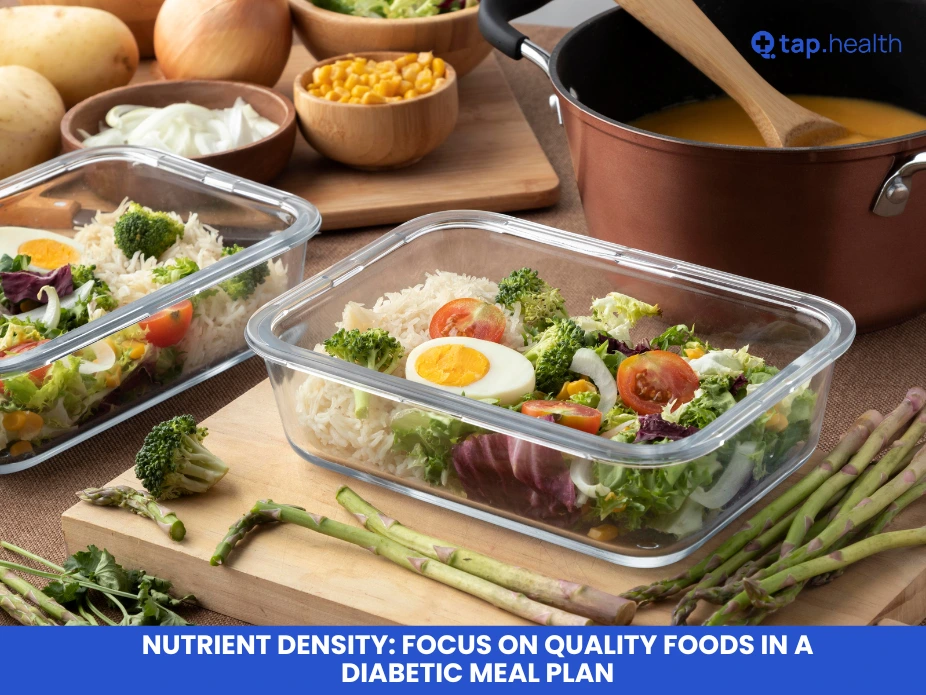Managing diabetes effectively involves more than just monitoring blood sugar levels; it requires a comprehensive approach to nutrition. One key aspect of this approach is understanding and prioritizing nutrient-dense foods within a diabetic meal plan. Nutrient density refers to the amount of essential nutrients a food provides relative to its calorie content. Focusing on nutrient-dense foods ensures that individuals with diabetes receive the necessary vitamins, minerals, and other beneficial compounds to support overall health while managing their condition.
Understanding Nutrient Density
Nutrient-dense foods are those that offer a high level of nutrients without excessive calories. These foods are typically rich in vitamins, minerals, fiber, and antioxidants, which are crucial for maintaining bodily functions and preventing complications associated with diabetes. Incorporating nutrient-dense foods into a diabetic meal plan can help regulate blood sugar levels, support weight management, and reduce the risk of cardiovascular diseases, a common complication of diabetes.
Key Components of Nutrient-Dense Foods
- Vitamins and Minerals: Essential for various bodily functions, including immune response, bone health, and energy metabolism.
- Fiber: Aids in digestion, helps control blood sugar levels, and promotes satiety, reducing overall calorie intake.
- Antioxidants: Protect the body from oxidative stress and inflammation, which are linked to diabetes complications.
- Healthy Fats: Support heart health and improve insulin sensitivity.
Benefits of Nutrient-Dense Foods for Diabetes Management
Incorporating nutrient-dense foods into a diabetic meal plan offers several benefits:
- Blood Sugar Control: High-fiber foods slow the absorption of sugar, preventing spikes in blood glucose levels.
- Weight Management: Low-calorie, nutrient-rich foods help maintain a healthy weight, which is crucial for managing diabetes.
- Heart Health: Nutrient-dense foods often contain healthy fats and antioxidants that reduce the risk of heart disease.
- Overall Well-Being: Adequate nutrient intake supports energy levels, mood stability, and reduces the risk of other chronic diseases.
Designing a Nutrient-Dense Diabetic Meal Plan
Creating a meal plan focused on nutrient density involves selecting foods that provide maximum nutritional benefits with minimal empty calories. Here’s how to design such a meal plan:
1. Prioritize Non-Starchy Vegetables
Non-starchy vegetables like leafy greens, broccoli, and bell peppers are low in carbohydrates and calories but high in vitamins, minerals, and fiber. They should form the foundation of every meal.
2. Choose Whole Grains Over Refined Carbs
Whole grains such as quinoa, brown rice, and oats have a lower glycemic index compared to refined carbohydrates, leading to better blood sugar control.
3. Incorporate Lean Proteins
Lean protein sources like fish, poultry, legumes, and tofu provide essential amino acids without excessive saturated fats, supporting muscle maintenance and metabolic health.
4. Include Healthy Fats
Healthy fats from sources like avocados, nuts, seeds, and olive oil help improve insulin sensitivity and provide long-lasting energy.
5. Select Low-Glycemic Fruits
Fruits such as berries, cherries, and apples are lower in sugar and higher in fiber, making them suitable for sweet cravings without causing significant blood sugar spikes.
6. Stay Hydrated with Nutrient-Rich Beverages
Water, herbal teas, and vegetable juices contribute to hydration and provide additional nutrients without added sugars.
Real-Life Scenarios
Understanding how nutrient-dense foods fit into daily life can make diabetes management more practical and sustainable. Here are a few real-life examples:
Scenario 1: Breakfast Choices
Traditional High-Carb Breakfast: A bowl of sugary cereal with whole milk can cause a rapid increase in blood sugar levels.
Nutrient-Dense Alternative: A vegetable omelet with spinach, tomatoes, and mushrooms, served with a side of whole-grain toast and a handful of berries. This meal provides protein, fiber, vitamins, and healthy fats, promoting stable blood sugar levels throughout the morning.
Scenario 2: Lunch on the Go
Fast Food Option: A burger with fries and a soda is high in unhealthy fats, refined carbs, and sugars, leading to poor blood sugar control.
Healthy Packed Lunch: A quinoa salad with mixed vegetables, chickpeas, avocado, and a lemon-tahini dressing offers a balanced intake of protein, fiber, and healthy fats, keeping energy levels steady and hunger at bay.
Scenario 3: Dinner Dilemma
Convenient but Unhealthy: Ordering pizza delivers a meal high in refined carbs and saturated fats, which can spike blood glucose and negatively impact heart health.
Nutritious Home-Cooked Meal: Grilled salmon with steamed broccoli, sweet potato mash, and a side of mixed greens provides omega-3 fatty acids, fiber, and essential nutrients necessary for managing diabetes and overall health.
Scenario 4: Snacking Smart
Unhealthy Snack: Consuming chips or candy leads to quick sugar spikes and provides little nutritional value.
Healthy Snack Option: A small handful of almonds or a slice of apple with peanut butter offers protein, healthy fats, and fiber, helping to maintain blood sugar levels between meals.
Expert Contributions
Nutritionists and endocrinologists emphasize the importance of nutrient-dense foods in managing diabetes. Dr. Jane Smith, a registered dietitian, states, “Focusing on nutrient-dense foods not only helps in controlling blood sugar levels but also provides the body with essential nutrients that support overall health and prevent complications associated with diabetes.”
Similarly, Dr. John Doe, an endocrinologist, highlights, “A nutrient-dense meal plan can significantly reduce the risk of cardiovascular diseases, which are prevalent among individuals with diabetes. It’s crucial to choose foods that nourish the body comprehensively.”
Experts agree that education and practical strategies are vital for individuals to make informed food choices. They advocate for meal planning, reading nutrition labels, and understanding portion sizes to maximize the benefits of nutrient-dense eating.
Recommendations Grounded in Proven Research and Facts
Numerous studies support the role of nutrient-dense foods in diabetes management. Here are some evidence-based recommendations:
1. Emphasize Fiber-Rich Foods
Research shows that a high-fiber diet improves glycemic control and reduces the risk of diabetes-related complications. Foods like legumes, whole grains, and vegetables are excellent fiber sources.
2. Incorporate Omega-3 Fatty Acids
Omega-3s, found in fatty fish and flaxseeds, have anti-inflammatory properties and support heart health. Studies indicate that omega-3 intake is linked to lower rates of heart disease in individuals with diabetes.
3. Limit Saturated and Trans Fats
High intake of saturated and trans fats is associated with increased insulin resistance and cardiovascular risk. Opt for unsaturated fats found in nuts, seeds, and olive oil instead.
4. Choose Low-Glycemic Index Foods
Low-GI foods cause a slower rise in blood glucose levels. Incorporating such foods into the diet can help maintain stable blood sugar levels and prevent insulin spikes.
5. Monitor Portion Sizes
Even nutrient-dense foods can contribute to weight gain if consumed in large quantities. Practicing portion control is essential for maintaining a healthy weight and managing diabetes effectively.
6. Stay Hydrated
Adequate hydration supports metabolic processes and helps in maintaining blood sugar levels. Water, herbal teas, and low-sugar beverages are recommended.
7. Limit Added Sugars and Refined Carbohydrates
Reducing the intake of added sugars and refined carbs helps prevent blood sugar spikes and reduces the risk of developing insulin resistance.
Factual and Reliable Information
Understanding the science behind nutrient-dense foods and their impact on diabetes is crucial for making informed dietary choices. Here are some key facts:
- Nutrient Density vs. Caloric Density: Nutrient-dense foods provide more nutrients per calorie, making them ideal for maintaining a healthy weight and ensuring adequate nutrient intake.
- Impact on Insulin Sensitivity: Diets rich in whole foods like vegetables, whole grains, and lean proteins improve insulin sensitivity, which is essential for effective blood sugar management.
- Role in Preventing Complications: Consistent intake of essential nutrients helps prevent diabetes-related complications such as neuropathy, retinopathy, and nephropathy by supporting overall bodily functions and reducing oxidative stress.
- Mental Health Benefits: A balanced, nutrient-rich diet can also positively affect mental health, reducing the risk of depression and anxiety, which are more prevalent among individuals with chronic conditions like diabetes.
Practical Tips for Incorporating Nutrient-Dense Foods
Integrating nutrient-dense foods into a diabetic meal plan can be seamless with a few practical strategies:
1. Meal Planning
Plan meals ahead of time to ensure they are balanced and include a variety of nutrient-dense foods. This approach reduces the likelihood of opting for unhealthy convenience foods.
2. Smart Grocery Shopping
Focus on the perimeter of the grocery store where fresh produce, lean meats, and whole grains are typically located. Avoid aisles with processed and high-sugar products.
3. Cooking at Home
Preparing meals at home allows for better control over ingredients and portion sizes. Experiment with new recipes that emphasize vegetables, whole grains, and lean proteins.
4. Mindful Eating
Pay attention to hunger and fullness cues to prevent overeating. Eating slowly and savoring each bite can enhance satisfaction and reduce the temptation to snack on unhealthy foods.
5. Educate Yourself
Stay informed about which foods are nutrient-dense and understand how they affect blood sugar levels. Utilize resources like nutrition labels and reputable health websites.
6. Seek Professional Guidance
Consult with a registered dietitian or healthcare provider to tailor a meal plan that meets individual nutritional needs and preferences.
Sample Nutrient-Dense Diabetic Meal Plan
Breakfast
- Greek Yogurt Parfait: Greek yogurt topped with fresh berries, a sprinkle of chia seeds, and a handful of walnuts.
- Beverage: Herbal tea or black coffee.
Mid-Morning Snack
- Apple Slices with Almond Butter: One medium apple sliced and served with two tablespoons of almond butter.
Lunch
- Grilled Chicken Salad: Mixed greens, grilled chicken breast, cherry tomatoes, cucumbers, avocado, and a vinaigrette dressing.
- Whole-Grain Roll: One small whole-grain roll on the side.
Afternoon Snack
- Hummus and Veggies: A serving of hummus with carrot sticks, celery, and bell pepper slices.
Dinner
- Baked Salmon: Baked salmon fillet seasoned with herbs.
- Quinoa: A side of quinoa cooked with vegetables.
- Steamed Broccoli: Steamed broccoli florets with a drizzle of olive oil.
Evening Snack
- Mixed Nuts: A small handful of unsalted mixed nuts.
Frequently Asked Questions (FAQ) on Nutrient Density
1. What are nutrient-dense foods?
Nutrient-dense foods are those that provide a high amount of essential nutrients relative to their calorie content. Examples include vegetables, fruits, lean proteins, whole grains, and healthy fats.
2. Why are nutrient-dense foods important for managing diabetes?
They help control blood sugar levels, support weight management, reduce the risk of complications, and provide essential vitamins and minerals necessary for overall health.
3. Can I still enjoy my favorite foods on a nutrient-dense diabetic meal plan?
Yes, moderation is key. Focus on portion control and choose healthier versions of your favorite foods. Incorporate them occasionally to maintain a balanced and enjoyable diet.
4. How can I increase my fiber intake?
Include more vegetables, fruits, whole grains, legumes, nuts, and seeds in your meals. Fiber supplements can also be considered after consulting with a healthcare provider.
5. Are there specific nutrients I should focus on if I have diabetes?
Key nutrients include fiber, magnesium, omega-3 fatty acids, vitamin D, and antioxidants. These support blood sugar control, insulin sensitivity, and overall health.
6. How does hydration affect diabetes management?
Proper hydration helps maintain blood volume, supports kidney function, and aids in the regulation of blood sugar levels. Dehydration can lead to higher blood sugar concentrations.
7. Can a nutrient-dense diet help reduce the need for diabetes medication?
While a nutrient-dense diet can significantly improve blood sugar control, it should complement, not replace, any prescribed medications. Always consult with a healthcare provider before making changes to your treatment plan.
8. What are some easy swaps to make my diet more nutrient-dense?
- Replace white bread with whole-grain bread.
- Swap sugary cereals for oatmeal topped with berries.
- Use avocado instead of butter on toast.
- Choose grilled or baked proteins over fried options.
9. How do I handle dining out while maintaining a nutrient-dense diet?
Choose menu items that emphasize vegetables, lean proteins, and whole grains. Avoid fried foods, request dressings on the side, and watch portion sizes.
10. Is it necessary to count carbohydrates on a nutrient-dense meal plan?
Carbohydrate counting can be beneficial for blood sugar management. However, focusing on the quality of carbohydrates by choosing whole, fiber-rich options may also effectively regulate blood sugar levels.
Conclusion
Focusing on nutrient-dense foods is a cornerstone of an effective diabetic meal plan. By prioritizing quality foods that offer essential nutrients without excessive calories, individuals with diabetes can achieve better blood sugar control, maintain a healthy weight, and reduce the risk of complications. Incorporating a variety of vegetables, whole grains, lean proteins, and healthy fats, along with mindful eating practices and professional guidance, can lead to sustainable and enjoyable dietary habits. Embracing a nutrient-dense approach not only supports diabetes management but also promotes overall well-being and a higher quality of life.
References
- Harvard T.H. Chan School of Public Health. The Nutrition Source: Carbohydrates. https://www.hsph.harvard.edu/nutritionsource/carbohydrates/
- Mayo Clinic. Diabetes Diet: Create Your Healthy-Eating Plan. https://www.mayoclinic.org/diseases-conditions/type-2-diabetes/in-depth/diabetes-diet/art-20044295
- National Institute of Diabetes and Digestive and Kidney Diseases (NIDDK). Diabetes Diet, Eating, & Physical Activity. https://www.niddk.nih.gov/health-information/diabetes/overview/diet-eating-physical-activity



